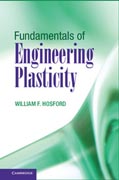
William Hosford's book is ideal for those involved in designing sheet metal forming processes. Knowledge of plasticity is essential for the computer simulation of metal forming processes and understanding the advances in plasticity theory is key to formulating sound analyses. The author makes the subject simple by avoiding notations used by specialists in mechanics. R. Hill's authoritative book, Mathematical Theory of Plasticity (1950), presented a comprehensive treatment of continuum plasticity theory up to that time; much of the treatment in this book covers the same ground, but focuses on more practical topics. Hosford has included recent developments in continuum theory, including a newer treatment of anisotropy that has resulted from calculations of yielding based on crystallography, analysis of the role of defects, and forming limit diagrams. A much greater emphasis is placed on deformation mechanisms and the book also includes chapters on slip and dislocation theory and twinning. INDICE: 1. An overview of the history of plasticity theory; 2. Yielding; 3. Stress and strain; 4. Isotropic yield criteria; 5. Bounding theorems and work principles; 6. Slip-line field theory; 7. Anisotropic plasticity; 8. Slip and dislocations; 9. Taylor and Bishop and Hill models; 10. Pencil glide calculations of yield loci; 11. Mechanical twinning and Martensitic shear; 12. Effects of strain hardening and strain-rate dependence; 13. Defect analysis; 14. Effects of pressure and sign of stress state; 15. Lower bound analysis; 16. Plasticity tests.
- ISBN: 978-1-107-03755-7
- Editorial: Cambridge University Press
- Encuadernacion: Cartoné
- Páginas: 276
- Fecha Publicación: 22/07/2013
- Nº Volúmenes: 1
- Idioma: Inglés
